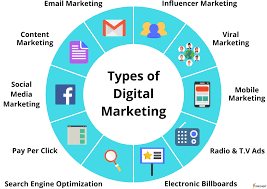The World of Digital Advertising: Exploring Your Options
With the rise of digital technology, advertising has evolved significantly, offering businesses a plethora of options to reach their target audiences effectively. Here are some key digital advertising options that can help you boost your brand’s visibility and drive conversions:
Social Media Advertising
Social media platforms like Facebook, Instagram, Twitter, and LinkedIn offer robust advertising options to target specific demographics based on interests, behaviours, and more. With precise targeting capabilities and engaging ad formats, social media advertising can help you connect with your audience in a meaningful way.
Search Engine Marketing (SEM)
SEM involves placing ads on search engine results pages to increase visibility for specific keywords related to your business. Google Ads is a popular SEM platform that allows you to bid on keywords and pay-per-click to drive traffic to your website. By targeting high-intent keywords, SEM can generate valuable leads for your business.
Display Advertising
Display advertising involves placing visual ads on websites, apps, or social media platforms to increase brand awareness. Display ads come in various formats such as banners, videos, and interactive ads. These visually appealing ads can capture the attention of users and drive them to engage with your brand.
Email Marketing
Email marketing remains a powerful digital advertising option for nurturing leads and retaining customers. By sending targeted emails with personalised content, promotions, or updates, businesses can build relationships with their audience and drive conversions over time.
Native Advertising
Native advertising blends seamlessly into the user experience of a platform by matching the form and function of the surrounding content. This non-disruptive approach allows brands to promote their products or services in a subtle manner that resonates with the audience without being intrusive.
Video Advertising
Video advertising has become increasingly popular due to its engaging nature and ability to convey messages effectively. Platforms like YouTube offer various video ad formats such as skippable ads, bumper ads, and in-stream ads that allow businesses to reach a wide audience through compelling visual storytelling.
In conclusion, the world of digital advertising offers a diverse range of options for businesses looking to enhance their online presence and drive results. By leveraging these digital advertising channels effectively, you can connect with your target audience on multiple touchpoints and achieve your marketing goals successfully.
Top 9 Advantages of Digital Advertising Options
- Highly targeted
- Cost-effective
- Measurable results
- Wide reach
- Flexible ad formats
- Quick implementation
- Enhanced brand visibility
- Improved targeting capabilities
- Continuous optimization
Challenges in Digital Advertising: Navigating Ad Blockers, Fraud, Fatigue, Privacy, Costs, and Attention Limits
- 1. Ad Blockers
- 2. Ad Fraud
- 3. Ad Fatigue
- 4. Privacy Concerns
- 5. Costly Competition
- 6. Limited Attention Span
Highly targeted
Digital advertising offers a significant advantage in its highly targeted approach, allowing businesses to tailor their ads to specific demographics, interests, and behaviours. By leveraging the wealth of data available online, digital advertisers can hone in on the most relevant audience segments for their products or services. This targeted approach not only increases the relevance of the ads but also enhances the chances of engaging with potential customers who are more likely to convert, ultimately maximising the effectiveness of advertising campaigns.
Cost-effective
In the realm of digital advertising options, one significant advantage lies in its cost-effectiveness. When compared to traditional advertising methods, digital advertising typically provides a superior return on investment (ROI) and cost efficiency. Businesses can reach a larger, more targeted audience at a fraction of the cost, making it a highly attractive option for companies looking to maximise their marketing budget and drive measurable results. This affordability factor allows businesses of all sizes to compete on a level playing field and achieve significant outcomes through strategic digital advertising campaigns.
Measurable results
One significant advantage of digital advertising options is the ability to achieve measurable results. Through digital advertising, businesses can track and analyse the performance of their campaigns in real-time, providing valuable insights into audience engagement, conversion rates, and ROI. This data-driven approach enables businesses to make informed decisions, optimise their strategies, and allocate resources effectively to maximise the impact of their marketing efforts.
Wide reach
Digital advertising offers the significant advantage of a wide reach, allowing businesses to connect with a global audience on diverse online platforms and devices. By leveraging digital advertising options, companies can expand their brand visibility beyond geographical boundaries and engage with potential customers worldwide. This broad reach not only increases brand awareness but also opens up opportunities for businesses to tap into new markets and drive growth on a global scale.
Flexible ad formats
Digital advertising provides businesses with the flexibility to choose from a diverse array of ad formats, ranging from simple text ads to captivating videos and interactive content. This versatility allows advertisers to tailor their messaging and creative approach according to their target audience’s preferences, ensuring maximum engagement and impact. By utilising various ad formats, businesses can effectively convey their brand message in a compelling manner that resonates with consumers across different digital platforms.
Quick implementation
One of the key advantages of digital advertising options is the quick implementation process. Digital ads can be set up and launched swiftly, enabling businesses to respond promptly to market trends and seize opportunities as they arise. This agility in deploying digital ads allows companies to stay ahead of the competition, adapt to changing consumer behaviours, and capitalise on timely promotions or events. By leveraging the speed of digital advertising, businesses can optimise their campaigns in real-time and maximise their impact in a fast-paced online environment.
Enhanced brand visibility
Enhanced brand visibility is a significant advantage of digital advertising options. By strategically placing ads on popular websites, social media platforms, or search engine results pages, businesses can significantly boost brand awareness among potential customers. The widespread reach of digital advertising allows brands to showcase their products or services to a vast audience, increasing the likelihood of attracting new customers and establishing a strong presence in the market. This increased visibility not only helps in attracting more leads but also reinforces brand recognition and credibility among consumers.
Improved targeting capabilities
Digital advertising offers improved targeting capabilities that empower businesses to connect with their target audience more effectively. Through advanced features such as geotargeting and retargeting, businesses can deliver tailored messages to specific demographics based on location, interests, and past interactions. This level of precision ensures that ads reach the right audience at the right time, increasing the likelihood of engagement and conversions. By leveraging these targeting capabilities, businesses can maximise the impact of their digital advertising efforts and achieve a higher return on investment.
Continuous optimization
Digital advertising offers the significant advantage of continuous optimization, enabling businesses to constantly refine and improve their ad campaigns based on real-time performance data. By monitoring key metrics such as click-through rates, conversion rates, and engagement levels, advertisers can make data-driven decisions to enhance the effectiveness of their campaigns. This iterative process of testing and optimization ensures that marketing efforts are always evolving to deliver the best possible results, ultimately maximising the impact and ROI of digital advertising initiatives.
1. Ad Blockers
One significant con of digital advertising options is the prevalence of ad blockers among internet users. With the rise of ad blockers, many online consumers actively choose to block digital ads, leading to a decrease in the visibility and effectiveness of advertising campaigns. This trend poses a challenge for businesses seeking to reach their target audience through online channels, as ad blockers limit the reach and impact of digital ads, potentially hindering marketing efforts and reducing the return on investment for advertising campaigns.
2. Ad Fraud
In the realm of digital advertising, one significant drawback is the prevalence of ad fraud. This malicious practice encompasses deceptive tactics like click fraud and bot traffic, where automated programs mimic human behaviour to generate fake clicks or impressions. Advertisers may unknowingly pay for interactions that have no real value, leading to wasted resources and skewed performance metrics. Ad fraud not only undermines the effectiveness of digital advertising campaigns but also erodes trust within the industry, highlighting the importance of implementing stringent measures to combat such fraudulent activities.
3. Ad Fatigue
One significant drawback of digital advertising options is ad fatigue, where audiences become weary and disengaged due to overexposure to digital ads. The constant bombardment of ads across various online platforms can lead to a decrease in their effectiveness as audiences grow tired of seeing the same advertisements repeatedly. Ad fatigue can result in reduced click-through rates, lower engagement levels, and ultimately hinder the overall success of digital advertising campaigns. Marketers need to be mindful of this con and implement strategies to combat ad fatigue by diversifying ad creatives, targeting specific audience segments, and carefully managing ad frequency to maintain audience interest and engagement.
4. Privacy Concerns
Privacy concerns are a significant con associated with digital advertising options. Some users express hesitancy towards digital ads because of the perceived invasion of privacy stemming from data collection and targeted advertising practices. The apprehension around how personal information is gathered, stored, and utilised for ad targeting purposes can lead to a sense of unease among consumers, impacting their trust in online advertising platforms. Addressing these privacy concerns and ensuring transparent data practices is crucial for building consumer confidence and maintaining ethical standards in the digital advertising landscape.
5. Costly Competition
In the realm of digital advertising, one significant drawback is the costly competition that arises when bidding for keywords and ad placements. This issue is particularly pronounced in competitive industries where businesses vie for visibility and audience attention. The high demand for popular keywords and prime ad placements can drive up costs, making it challenging for smaller businesses with limited budgets to compete effectively in the digital advertising landscape. As a result, the cost factor can act as a barrier to entry for some businesses looking to establish their online presence through paid digital advertising strategies.
6. Limited Attention Span
In the realm of digital advertising options, a significant drawback lies in the limited attention span of online audiences. With a multitude of ads competing for visibility and engagement, capturing and maintaining audience interest can prove to be a daunting task. In an environment where distractions abound and users are inundated with information, standing out from the crowd and holding onto viewers’ attention poses a considerable challenge for advertisers looking to make an impact in the digital landscape.


